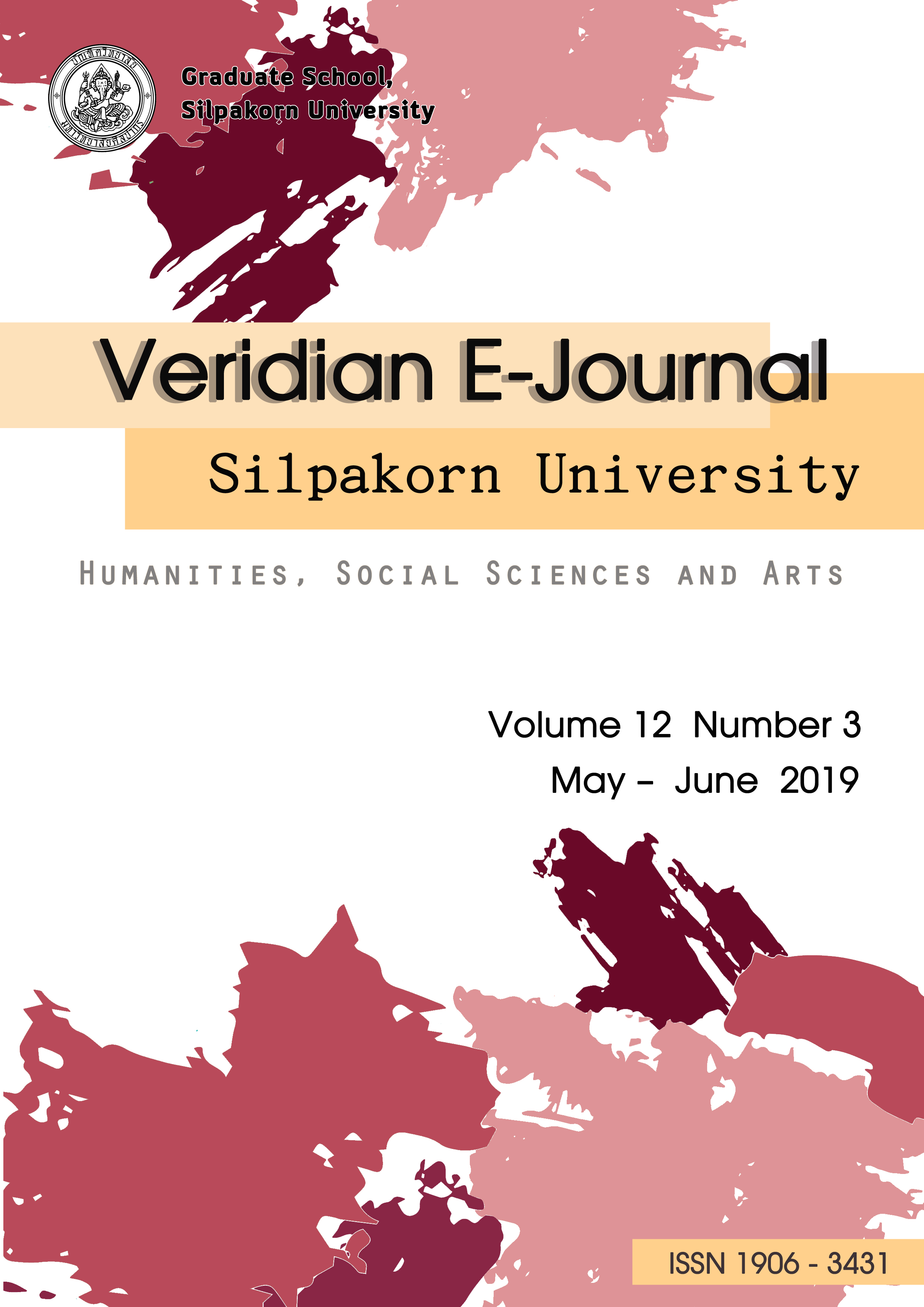การใช้วัจนกรรมในเพลงประจำสถาบันอุดมศึกษาของรัฐ (Speech Act Usage in Song of State Institutions of Higher Education)
Main Article Content
Abstract
บทความวิจัยนี้มีวัตถุประสงค์ เพื่อศึกษาการใช้วัจนกรรมที่พบในเพลงประจำสถาบันอุดมศึกษา ของรัฐ ผู้วิจัยเก็บข้อมูล โดยรวบรวมเพลงประจำสถาบันอุดมศึกษาของรัฐจากเว็บไซต์ต่าง ๆ ได้แก่ 1) เว็บไซต์ประจำสถาบันอุดมศึกษาของรัฐ เช่น www.su.ac.th (มหาวิทยาลัยศิลปากร) เป็นต้น 2) เว็บไซต์รวบรวมบทเพลงสุนทราภรณ์ (www.websuntaraporn.com) 3) เว็บไซต์เผยแพร่วิดีโอของยูทูป (www.youtube.com) และ 4) สารานุกรมเสรี (https://th.wikipedia.org) รวมจำนวนเพลงทั้งสิ้น 915 เพลง ทั้งนี้ ผู้วิจัยจะใช้เกณฑ์การแบ่งประเภทวัจนกรรมของ John R. Searle เป็นแนวทางในการวิเคราะห์ครั้งนี้
ผลการศึกษาพบว่า เพลงประจำสถาบันอุดมศึกษาของรัฐ มีการใช้วัจนกรรม 5 กลุ่ม 14 ประเภท ดังนี้ 1) วัจนกรรมกลุ่มบอกกล่าว (Representatives หรือ assertive) ได้แก่ วัจนกรรมการยืนยัน (asserting) และวัจนกรรมการบรรยาย (describing) 2) วัจนกรรมกลุ่มชี้นำ (Directives) ได้แก่ วัจนกรรมการขอร้อง (requesting) วัจนกรรมการวิงวอน (praying) วัจนกรรมการสั่ง (ordering หรือ commanding)และวัจนกรรมการถาม (questioning) 3) วัจนกรรมกลุ่มผูกมัด (Commissives) ได้แก่ วัจนกรรมการสัญญา (promising) วัจนกรรมการปฏิญาณ (pledging) และวัจนกรรมการสาบาน (vowing) 4) วัจนกรรมกลุ่มแสดงความรู้สึก (Expressives) ได้แก่ วัจนกรรมการขอโทษ (apologizing) วัจนกรรมการอำลา (expressing condolences) วัจนกรรมการแสดงความยินดี (congratulating) และวัจนกรรมการขอบคุณ(thanking) และ 5) วัจนกรรมกลุ่มแถลงการณ์ (Declarative) คือ วัจนกรรมการประกาศ (declaring) วัจนกรรมที่พบมากที่สุด คือ วัจนกรรมกลุ่มบอกกล่าว และวัจนกรรมกลุ่มแสดงความรู้สึก รองลงมา คือวัจนกรรมกลุ่มชี้นำ และวัจนกรรมกลุ่มผูกมัด และ วัจนกรรมที่พบน้อยที่สุด คือ วัจนกรรมกลุ่มแถลงการณ์
The objective of this research article was to study the usage of Speech Acts in Song of State Institutions of Higher Education. The author collected the data about these songs from many websites: 1) official websites of State Institution of Higher Education 2) www.websuntaraporn.com 3) www. youtube.com and 4) www.th.wikipedia.org. The total songs in this research are 915. In addition, the author applied the classification criteria of types of Speech Acts created by John R. Searle (1976) and adapt it as a guildline in this research.
Research findings were shown that there are 5 main groups (13 types) of Speech Acts in these songs as follows : 1) Representatives or assertive, for example, asserting and describing 2) Directives, for examples, requesting, praying, ordering or commanding and questioning 3) Commissives, for example, promising, pledging and vowing 4) Expressives, for example, apologizing, expressing condolences, congratulating, and thanking 5) Declarative. Furthermore, the author investigated that the most common Speech Acts in these songs are Representatives and Expressives, following by Directives and Commissives; and Declarative is the least common Speech Acts in these songs.

